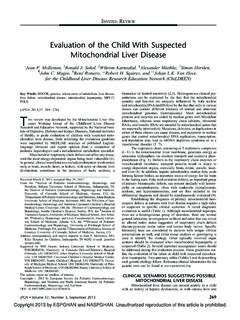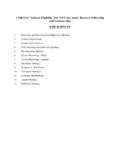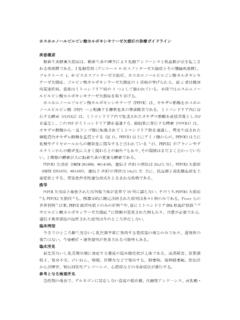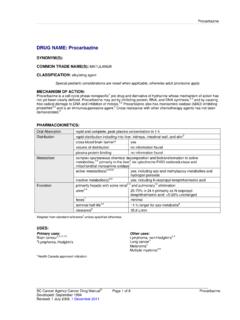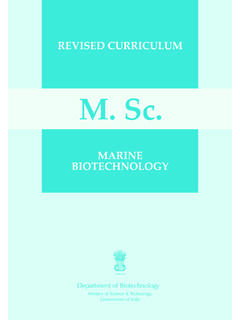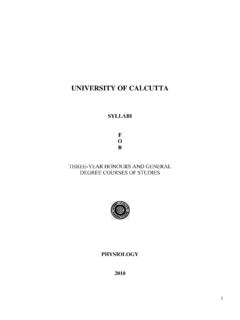Transcription of Nanorobotics - Fractal Navigator
1 Nanorobotics Ummat , Dubey , 2, Sharma , Mavroidis , *1 Department of Mechanical and Industrial Engineering, Northeastern University, 360, Huntington Avenue, Boston, Massachusetts 02115, USA. 2 Department of Mechanical and Aerospace Engineering, Rutgers University, 98 Brett Road, Piscataway, NJ 08854, USA * Author for correspondence: Email: Tel: (617) 373-4121; Fax: (617) 373-2921 Keywords: Nanorobotics , Molecular Motors, Nanomachines, Nanodevices, Nanomotors, Bionanotechnology Abstract This chapter focuses on the state of the art in the field of nano-robotics by describing various molecular level systems and associated design and control issues. Nano-robots are controllable machines at the nano (10-9) meter or molecular scale that are composed of nano-scale components. With the modern scientific capabilities, it has become possible to attempt the creation of nanorobotic devices and interface them with the macro world for control.
2 There are countless such machines that exist in nature and there is an opportunity to build more of them by mimicking nature. Even if the field of Nanorobotics is fundamentally different than that of macro robots due to the differences in scale and material, there are many similarities in design and control techniques that eventually could be projected and applied. A roadmap towards the progression of this field is proposed and some design concept and philosophies are illustrated. Two types of control mechanisms are given with examples and further hybrid mechanisms are proposed. There are many applications for nanorobotic systems and its biggest impact would be in the area of medicine. Table of Contents 1. 2. nanorobotic DEVICES USING NATURE S PROTEIN BASED MOLECULAR ATP SYNTHASE A TRUE NANO ROTARY MOTOR [2].
3 5 THE KINESIN, MYOSIN, DYNEIN AND FLAGELLA MOLECULAR DNA BASED MOLECULAR THE DNA INORGANIC (CHEMICAL) MOLECULAR THE THE OTHER INORGANIC MOLECULAR OTHER PROTEIN BASED MOTORS UNDER VIRAL PROTEIN LINEAR SYNTHETIC CONTRACTILE 3. Nanorobotics DESIGN AND DESIGN OF NANO ROBOTIC THE DESIGN PHILOSOPHY AND ARCHITECTURE FOR THE BIO- nanorobotic COMPUTATIONAL & EXPERIMENTAL METHODS - DESIGNING BIO nanorobotic CONTROL OF nanorobotic INTERNAL CONTROL MECHANISM ACTIVE AND EXTERNAL CONTROL 4. 5. 21. Introduction Nanotechnology can best be defined as a description of activities at the level of atoms and molecules that have applications in the real world. A nanometer is a billionth of a meter, that is, about 1/80,000 of the diameter of a human hair, or 10 times the diameter of a hydrogen atom.
4 The size-related challenge is the ability to measure, manipulate, and assemble matter with features on the scale of 1-100nm. In order to achieve cost-effectiveness in nanotechnology it will be necessary to automate molecular manufacturing. The engineering of molecular products needs to be carried out by robotic devices, which have been termed nanorobots. A nanorobot is essentially a controllable machine at the nano meter or molecular scale that is composed of nano-scale components. The field of Nanorobotics studies the design, manufacturing, programming and control of the nano-scale robots. This review chapter focuses on the state of the art in the emerging field of Nanorobotics , its applications and discusses in brief some of the essential properties and dynamical laws which make this field more challenging and unique than its macro scale counterpart.
5 This chapter is only reviewing nano-scale robotic devices and does not include studies related to nano precision tasks with macro robotic devices that usually are also included in the field of nano-robotics. Nanorobots would constitute any passive or active structure (nano scale) capable of actuation, sensing, signaling, information processing, intelligence, swarm behavior at nano scale. These functionalities could be illustrated individually or in combinations by a nano robot (swarm intelligence and co-operative behavior). So, there could be a whole genre of actuation and sensing or information processing nano robots having ability to interact and influence matter at the nano scale. Some of the characteristic abilities that are desirable for a nanorobot to function are: i.
6 Swarm Intelligence decentralization and distributive intelligence ii. Cooperative behavior emergent and evolutionary behavior iii. Self assembly and replication assemblage at nano scale and nano maintenance iv. Nano Information processing and programmability for programming and controlling nanorobots (autonomous nanorobots) v. Nano to macro world interface architecture an architecture enabling instant access to the nanorobots and its control and maintenance There are many differences between macro and nano-scale robots. However, they occur mainly in the basic laws that govern their dynamics. Macro scaled robots are essentially in the Newtonian mechanics domain whereas the laws governing nanorobots are in the molecular quantum mechanics domain. Furthermore, uncertainty plays a crucial role in nanorobotic systems.
7 The fundamental barrier for dealing with uncertainty at the nano scale is imposed by the quantum and the statistical mechanics and thermal excitations. For a certain nano system at some particular temperature, there are positional uncertainties, which can not be modified or further reduced [1]. The nanorobots are invisible to naked eye, which makes them hard to manipulate and work with. Techniques like Scanning Electron Microscopy (SEM) and Atomic Force Microscopy (AFM) are being employed to establish a visual and haptic interface to enable us to sense the molecular structure of these nano scaled devices. Virtual Reality (VR) techniques are currently being explored in nano-science and bio-technology research as a way to enhance the operator s perception (vision and haptics) by approaching more or less a state of full immersion or telepresence.
8 The development of nanorobots or nano machine components presents difficult fabrication and control challenges. Such devices will operate in microenvironments whose physical properties differ from those encountered by conventional parts. Since these nano scale devices have not yet been fabricated, evaluating possible designs and control algorithms requires using theoretical estimates and virtual interfaces/environments. Such interfaces/simulations can operate at various levels of detail to trade-off physical accuracy, computational cost, number of components and the time over which the simulation follows the nano-object behaviors. They can enable nano-scientists to extend their eyes and hands into the nano-world and also enable new types of exploration and whole new classes of experiments in the biological and physical sciences.
9 VR simulations can also be used to develop virtual assemblies of nano and bio-nano components into mobile linkages and predict their performance. 3 Nanorobots with completely artificial components have not been realized yet. The active area of research in this field is focused more on molecular robots, which are thoroughly inspired by nature s way of doing things at nano scale. Mother Nature has her own set of molecular machines that have been working for centuries, and have been optimized for performance and design over the ages. As our knowledge and understanding of these numerous machines continues to increase, we now see a possibility of using the natural machines, or creating synthetic ones from scratch, using nature s components. This chapter focuses more on molecular machines and explores various designs and research prevalent in this field.
10 The main goal in the field of molecular machines is to use various biological elements whose function at the cellular level creates motion, force or a signal as machine components. These components perform their preprogrammed biological function in response to the specific physiochemical stimuli but in an artificial setting. In this way proteins and DNA could act as motors, mechanical joints, transmission elements, or sensors. If all these different components were assembled together in the proper proportion and orientation they would form nano devices with multiple degrees of freedom, able to apply forces and manipulate objects in the nanoscale world. The advantage of using nature's machine components is that they are highly efficient and reliable. Nanorobotics is a field which calls for collaborative efforts between physicists, chemists, biologists, computer scientists, engineers and other specialists to work towards this common objective.


